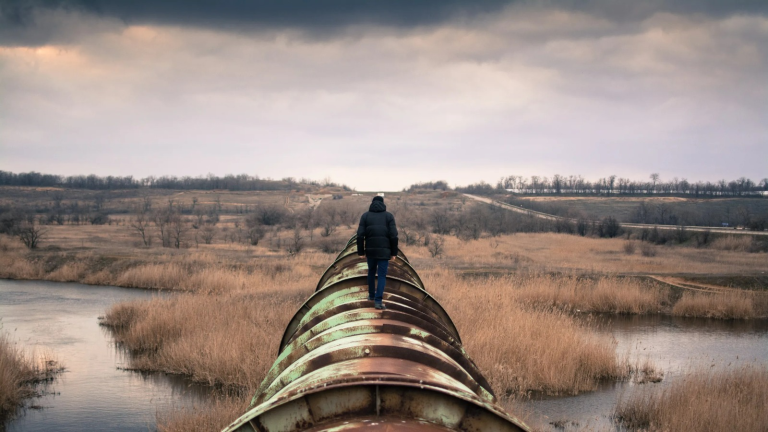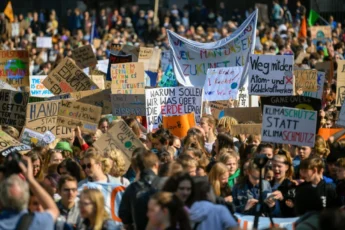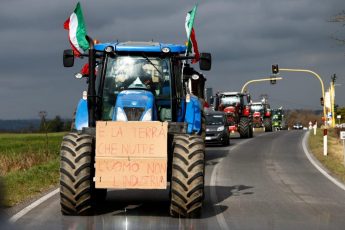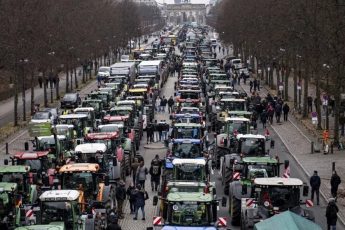
by PRECARIOUS DIS-CONNECTIONS (Italy)
The war in Ukraine awakened the European Union from its daydream of post-pandemic reconstruction. Imagined as the coherent outcome of several interconnected plans – the Recovery Plan, the NextGenerationEU plan, and the European Green Deal – this taken-for-granted reconstruction is now forced to pass through previously unexpected rough paths. The war in Ukraine is producing effects far beyond the battleground. Still, it has not forced Von der Leyen to renounce the evocative power of planning, as the political chronicle of these days demonstrates. Both the ‘democratic’ policy of sanctions and the struggle over energy and strategic raw materials supplies are constitutive parts of the world-wide rearrangement of states’, unions’, and capital’s relations. Although the armed conflict is not spreading everywhere, it is challenging certain cornerstones of the global order with the violence of a new world war. Thus, the recent European efforts to grant itself a strong position in the uncertain new order must be understood in this transnational, fragmented, open, and competitive – but still integrated and connected – scenario. The ecological transition represents the attempt to construct a sustainable ‘green’ environment for capital accumulation, that is for attracting new capital and pointing out additional investment outlets.
In its original daydream of post-pandemic reconstruction – only partially shattered by the war – the Union strengthened the relationship with its member states by means of billions of fundings. It also extended its reach beyond its own institutional borders through the financial instruments and regulations adopted within the framework of the ecological transition. The crisis linked to the pandemic had shown world market’s weak points, thus displaying where it was necessary to intervene to reinforce the efficiency of some existing order’s processes – the resilience of value chains, the availability of essential and skilled workers, and the control over resources needed for hi-tech production. Today, the war highlights with the highest violence possible the impossible planning of that balance the Union sought after in the last two years. The stumbles in European planning prove that we are facing transnational crises. As such, no state or union of states has the power to ultimately govern these crises’ causes, nor can it aspire to fully foresee their effects. This also explains the desperate race to pick up the threads of the shattered global order, to try to exercise new political forms of precarious hegemony, or to secure profis where global value chains proved to be less resilient than expected. Describing the force and radicality with which these crises are overthrowing a specific shape of globalisation, The Economist – for centuries an influential institution defending capital interests – spoke of the war effects as a “world catastrophe”. In particular, The Economist referred to the future of food and energy shortages that awaits a world unable to overcome its “fragilities”. The Economist fails to note that the food and energy crisis, as well as the climate crisis more generally, are not future concerns, but an already-harsh reality for a large part of the world’s population. However, The Economist evokes the spectre of catastrophe precisely because it thinks to know what must be done to exorcise it and most importantly who must pay its prices.
The European Union now seriously considers the possibility of doing without Russian gas. This was until recently deemed to be so obvious that it was part of those strategic sources needed for the green transition no more than five months ago. In this sense, RePowerEUis the plan which aims to turn a problem into an opportunity, as EU Economic Commissioner Gentiloni has been advocating for a couple of months now. By re-powering itself, the Union tries both to attract its neighbours and to guide its member States. For it can at most aspire to attract and orientate, and not to fully direct the whole processes to be organised through plannings, the European plan is not a classic plan. Nonetheless, the Commission cannot but make spasmodic appeal to that term and its evocative power. While devising their domestic plans, national governments have to deal with the fact that their plannings are predetermined by the Union’s power. Simultaneously, both the rigidities of individual states and the transnational movements these strive to govern – albeit ungovernable – results in the EU producing ‘strategies’ rather than real ‘plans’.
The war breaks in like a barbaric accident at the beginning of the RePowerEU planto justify the urgency of its measures. According to the Commission, it has triggered a series of critical processes affecting EU’s relationship with both Russia and with its member States. In particular, the attempt to avoid subsidising a now unsustainable trade partner has disappointed those countries that are most closely linked to Russian supplies. In order to break down this resistance, the European strategy envisages the possibility of investing almost 300 billion euros in new infrastructures and technological development, also to increase renewable energy sources’ profitability. Thus, while the purchase of Russian gas by sea (which, however, does not concern the Eastern European chain) will cease by the end of the year, Hungary obtains the entry of gas by land. However, most of these fundings are contingent to the strategic goals contained in the various national reconstruction plans and linked to the green transition, on which Orban has never agreed with Brussels. While this tug-of-war continues, the construction of the EU Energy Platform is envisaged to strengthen the Union’s influence on its members and neighbours. The Platform allows for centralising the collection of data on partner countries’ energy needs, so that resources can be better distributed. This Energy Union will certainly be open to Ukraine, Moldova, Georgia, and the Western Balkans, so that these countries could escape Russian dependencies through the integration within the single European market. In short, this constitutes a new chapter in the long process of Eastern European integration, which passes through the expansion of the single market, greater competitiveness, and now also the opening of new outlets for Western ‘green’ capital. Logistical integration before political one, since the latter is still expected to take no less than a decade. This integration should save the movement of goods and energy from the various supply chains ‘bottlenecks’ that recent crises have caused. It also aims to anticipate new crises linked to potential worker insubordinations that could jeopardise the greentransition. In short, the energy urgency establishes an order of priorities that justifies stopping all resistance. These are rather forced to conform to the Union’s long-term strategic objectives by adopting short-range national initiatives guided by the plan. The goals of saving energy, diversifying energy supplies, accelerating the transition to renewables, and combining investments and reforms give substance to the European ambition to reflect the differences among its States and “propose a variety of balanced responses”, knowing well that in the current situation “no Member State can tackle this challenge on its own” and that, at the same time, independence from Russian supplies will lead to new dependencies along the Atlantic axis.
RePowerEUis thus also emblematic of Von der Leyen Commission’s effort to summarise within its plans strategic ambitions and initiatives that states cannot but meet if they want to reproduce their societies in the short term. Moreover, as it aims to strengthen its grip on the movement of capital, goods, and individuals inside and outside the borders of the European single market, the RePowerEU planattempts to bend otherwise catastrophic transnational dynamics in its favour. In this sense, it forges commercial friendships with states that occupy a strategic and previously unforeseen position in the geography of the current crisis because of the availability of resources there. Given that, EU’s energy policies are a piece of its attempt to establish a precarious hegemony over transnational valorisation processes. EU attempts to occupy a powerful position vis-à-vis its international partners, attracting and directing capital to strategic sectors and seeking a difficult mediation between its own long-term interests and its members’ short-term ones. For their part, member states are continually caught between conflicting and contradictory needs both within and outside their borders. While it is true that European planning has increased governments’ spending capacities and their intervention in setting standards for directing the movement of capital, goods, and people, it is nevertheless evident that these planning elements are always partial, as well as their dynamics which are eventually unforeseeable in their final effects.
National governments, therefore, have no choice but to resort to European economic aid to prevent a large segment of their populations from falling below the minimum level of reproduction and to secure their legitimacy. On the other hand, when it comes to alleviate the transition-led inflation, the Commission and the ECB advise states to intervene on taxation while adhering to the holy principle of keeping budgets in order. We thus register the “one-off” subsidies, such as “Grandpa” Draghi’s €200 summer allowance or the much more conspicuous €1,400 in Germany, which by the way is reserved to the chemical sector. However, what seems to be most important – at least according to the Bank of Italy governor, Ignazio Visco – is that wages do not raise as they did in the 1980s. This means that no one can except to avoid paying the cost of inflation. The wartime ecological transition therefore also puts a definitive end to the pandemic suspension of austerity measures, as well as to the hopes of those who glimpsed in that suspension the auspices of some sort of ‘social’ Europe.
We can thus question the recent European strategy trying to grasp and anticipate those processes that will necessarily affect member States’ room for manoeuvre, their policies for managing production and social reproduction, and their attempts to unequally distribute the ecological cost of transition policies.
With the imperative to make industrial production more efficient by reducing energy consumption, the Union follows up on the emission reduction targets already set with the Fit for 55 programme in 2020, by which EU should cut 55% of harmful emissions by 2030. With the additional belt-tightening required to protect the volatile energy supply, the Union takes further its energy transition policies, fully legitimised by the ‘unexpected’ war circumstances. Specifically, this acceleration is expected to increase the hardships of those already experiencing a housing emergency, i.e. struggling to pay their bills. At the same time, the skills required to complete buildings and infrastructures’ modernisation will change millions of workers’ employment conditions. They will be forced to ‘upskill and reskill’, signalling how these buzzwords and conditions, which have been shaping European discourses and processes for some years now, are the restorative cure the Union deems necessary to emerge strengthened from the transnational crisis opened by the war.
Diversification, complementing the centralisation of energy storage, demonstrates the strategic relevance of ecological transition in the economy of the plan to re-power the European Union. The ecological transition is the policy through which the Union aims to attract capital by providing it with a sustainable institutional environment. It makes it possible to draw from a substantial set of instruments and financial markets (including carbon market), thus promoting long-term investment in directions previously unexplored by capitalist accumulation. It finally allows to rewrite the geography of its ‘trusted partners’ under the banner of single market enlargement. In this perspective, the ecological transition not only does not cease to be profit-driven, but neither does it find its suspension in war. On the contrary, the wartime has relaunched ecological planning, that is EU’s attempt to restructure the energy market by assigning it a strategic value. Under the banner of ‘diversification’, the EU allows its members very un-ecological choices, such as exploiting coal mines a little longer than originally planned, or giving new impetus to nuclear power, or continuing the extraction of gas from the European soil. Then, it intensifies the infrastructural interconnections within and outside the European institutional space.
The vaunted acceleration on renewables implies investments and reforms that States will find increasingly difficult to avoid. First, because the Commission linked fundings to reforms. Then, because it forced the inclusion of both in the national reconstruction plans’ strategic objectives. The redefinition and greater integration of EU’s energy system’s geography is now at stake. Thus, the plan cannot but make its strategic objectives weigh on the initiatives of individual states. “While most of the targets and objectives are European and require a strong coordination,” RePowerEU significantly states, “implementation of many of the measures remain with Member States and require targeted reforms and investments”. From greater investment in weapons, considered a strategic element of the cohesion and security of democracy, to the promotion of the EU Solar Industry Alliance, prompted by innovative research financed through the Horizon Europe programme – in the new wartime scenario, the redefinition of the milestones each national plan is required to follow happens along this dual dimension, namely, investments and reforms. The emphasis on industrial leadership which should guide the transition cannot go unnoticed. Introduced with the first pre-war planning attempts, it now finds itself charged with the task of pulling the Union into the current phase of extreme global competitiveness. Thus, the production of photovoltaic panels is to double by 2025, favoured by the high cost of the hitherto most exploited sources of energy and the bureaucratic simplifications recommended by the Union. Finally, to complete this transition towards the new capital investment sectors, the problem of skilled labourers’ availability meeting European industrial capital new needs reappears. Therefore, the guidelines contained in the Pact for Skills constitute a fundamental pivot of the alliance. This should form a hubin which industrial ecosystems – especially the digital and green ones – will share tools, knowledge, training courses, apprenticeship opportunities and other “good practices” for their workers. For instance, Italy realises the first round of workers reskillingfor greenand sustainable construction through the Orlando-Lamorgese protocol. Significantly, this protocol does not renounce migrants’ labour – on whose lives hangs the threat of residence permits – who will be recruited through cooperatives to provide cheap labour on construction sites. Behind the Italian fraud on private building renovations bonuses and the urgency of drastic changes in individual habits to cope with the energy emergency (“let’s turn off the air conditioners!”), the ambition of the European strategy to boost construction and industrial production by reducing unsustainable energy waste is also making its way to Italy.
Finally, reforms and investments demonstrate the tension that runs through European planning, which is now required to handle the wartime turmoil. In this scenario, some states are trying to negotiate with the Union on sustainable transition times and modalities for they cannot cope alone with the costs of transition, especially commodity price inflation. As a response, the Commission reminds those states that the fundings loaned them have costs, which are not only economic but also political and administrative. One of these is the homogenisation of conditions for permits and concessions. The same operating standards should ensure investments in new industrial facilities, the modernisation of buildings, and the optimised exploitation of the resources still available on European soil. This homogenisation is considered paramount to realise long-term strategies that can be functionally reflected in local realities, preventing refusals and resistances. Concretely, this means that states have to add to their National Reconstruction Plans a specificchapter explaining how they contribute to the greater integration and strengthening of the Union’s Energy Community.
The economic, administrative and jurisdictional imprint that the Union establishes through its planning once again signals greentransition’s industrial and financial dimensions, displaying EU’s attempts to create the conditions for the emergence of a new ecological regime of capital accumulation. Such planning does not follow classical planning trajectories, for it does not take on the task of resolving the political contradictions that run through society; rather, as the agreement found with Hungary demonstrates, EU’s planning effort tends to bypass them and offload them onto national policies, with all due respect for democratic standards. What the EU certainly claims to be doing with its ecological, financial, and industrial policies is to draw the institutional framework within which precarious workers, migrants, and ecologist activists are forced to measure themselves in order to build a collective and transnational force against the war and the impossible alternative it poses between western ecological and armed democracy and Putin’s authoritarianism. Building a transnational politics of peace, then, means freeing ourselves from the blackmail of catastrophe, either warlike or climate. Building a transnational politics of peace on the side of precarious workers, women, and migrants means opposing a sense of possibility to the inevitability of catastrophe.





